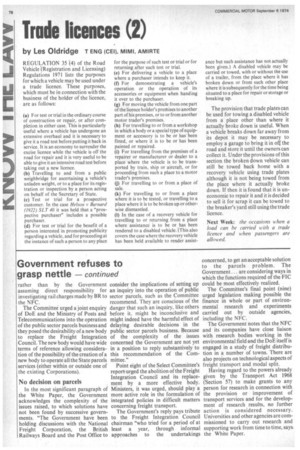Trade licences (2)
Page 80

If you've noticed an error in this article please click here to report it so we can fix it.
by Les Oldridge T ENG (CEO, MIMI, AMIRTE REGULATION 35 '(4) of the Road Vehicle '(Registration and Licensing) Regulations 1971 lists the purposes for which a vehicle may be used under a trade licence. These purposes, which must be in connection with the business of the holder of the licence, are as follows:
(a) For test or trial in the ordinary course of construction or repair, or after completion in either case. This is particularly useful where a vehicle has undergone an extensive overhaul and it is necessary to give it a road test before putting it back in service. It is an economy to surrender the excise licence while the vehicle is off the road for repair and it is very useful to be able to give it an intensive road test before taking out a new licence.
(b) Travelling to and from a public weighbridge for ascertaining a vehicle's unladen weight, or to a place for its registration or inspection by a person acting on behalf of the Secretary of State.
(c) Test or trial for a prospective customer. In the case He!son v Barnard (1922) SLT 40 it was held that a "prospective purchaser" includes a possible purchaser.
(d) For test or trial for the benefit of a person interested in promoting publicity regarding a vehicle, and for proceeding at the instance of such a-person to any place for the purpose of such test or trial or for returning after such test or trial.
(e) For delivering a vehicle to a place where a purchaser intends to keep it.
(f) For demonstrating a vehicle's operation or the operation of its accessories or equipment when handing it over to the purchaser.
(g) For moving the vehicle from one part of the licence holder's preitises to another part of his premises, or to or from another motor trader's premises. • (h) For travelling to or from a workshop in which a body or a special type of equipment or accessory is to be or has been fitted, or where it is to be or has been painted or repaired.
(i) For travelling from the premises of a repairer or manufacturer or dealer to a place where the vehicle is to be transported by train, ship or aircraft, or for proceeding from such a place to a motor trader's premises.
(j) For travelling to or from a place of sale.
(k) For travelling to or from a place where it is to be tested, or travelling to a place where it is to be broken up or otherwise dismantled.
(I) In the case of a recovery vehicle for travelling to or returning from a place where assistance is to be or has been rendered to a disabled vehicle. (This also covers the case where the recovery vehicle has been held available to render assist ance but such assistance has not actually been given.) A disabled vehicle may be carried or towed, with or without the use of a traiter, from the place where it has broken down or from such other place where it is subsequently for the time being situated to a place for repair or storage or breaking up.
The provision that trade plates can be used for towing a disabled vehicle from a place other than where it actually broke down is useful. When a vehicle breaks down far away from its depot it may be necessary to employ a garage to bring it in off the road and store it until the owners can collect it. Under the provisions of this section the broken down vehicle can still be towed back home with a recovery vehicle using trade plates although it is not being towed from the place where it actually broke down. If then it is found that it is uneconomic to repair it and it is decided to sell it for scrap it can be towed to the breaker's yard still using the trade licence.
Next Week: the occasions when a load can be carried with a trade licence and when passengers are allowed.


























































































































































